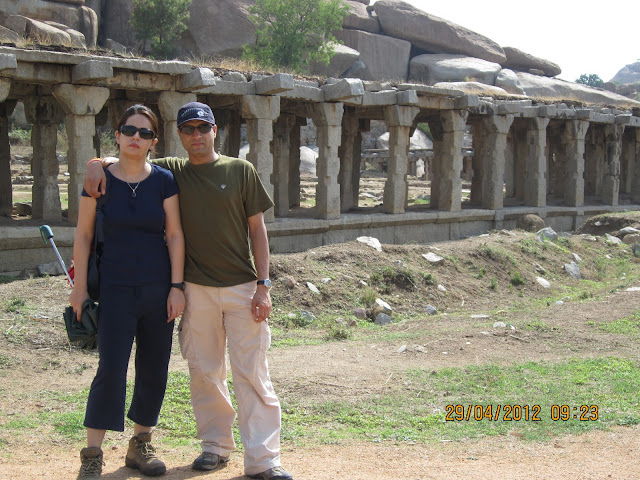So by now , Virupaksha Temple was explored and done with. The temple was a complex structure which I would need a guide (person/book) to understand better. I suggest you pick up the hand book called Hampi by ASI which is available at a cost of Rs 100. I picked this book much later when most of the exploration was already done. Logic at its best !!!.
Virupaksha Bazaar : Facing the Virupaksha Temple is once glorious Hampi bazaar flanked on both sides by double storyed structures. Most of it lies in ruins. The time I had visited the area was very dirty and crying for attention, Some clicks of this
So now what? Where do we start the exploration ?? Moving towards our car a guide approached us and offered to show us around for Rs 500. We agreed.
Am attaching a map for exploration which I have clicked from the book Hampi Ruins by A.H. Longhurst.
The green arrow represents where we entered Hampi . The red arrow depicts the Virupaksha temple and Hampi bazaar area and the blue arrow marks the Tungabhadra river zone.
On entering Hampi the previous day we had passed the Mohammadan tomb and darga area.
Muhammadans have tomb building as a very important part of their religion have left a few monuments outside the city. But they are not of much architectural importance.
So now we had the guide with us. Off we went ..
This was the start point.
Krishna Temple.
This is Krishna Deva Raya additon to the city and he built it around 1513 to enshrine an image of Krishna.which he had captured during his expedition against Orissa. It is a beautiful temple with all the shrines mandapas and pillared verandhas in place all around..
East of the temple lie one of the ruined bazaars...they must have been hub of activity druing happier times..
Just beyond the Krishna temple and on the western side of the road are the following monuments :
 |
| Outside Kadalekalu Ganesha Temple |
 |
| Monolithic Ganesha statue |
 |
| Close up of the belly God |
This is the great monolithic image of popular belly god Ganesha stands under the open pillared mandapa on the rocky hillock. a few yards further up the road one arrives tot he top of the hill and then the road descends suddenly to the Hampi bazaar below.
 |
| North view from Hemkuta Hill |
Now we are off to explore another zone..
 |
| March on!! Hubby and the guide |
 |
| Monolithic Narasimha statue |
 |
| 7 serpants hood and guard |
 |
| Large Linga stone next to the Narasimha statue |
 |
| Note that it is surrounded by water |
This is the huge monolithic statue of Narasimha (man-lion incarnation of Vishnu).
As per the stone inscription on a stone slab set up in front of the enclosure it is hewn out of a single boulder ( of granite )by a Brahman in 1528. It is 22 feet high and carved with great care. Although in a mutilated state it remains one of the most striking objects in the ruins. Arms are cut off. 7 hooded nags curls overhead. Originally there was a figure of Lakshmi perched on the left thigh, but what remains of it a shapely hand... The construction indicates it was to be enshrined but that idea never saw the light of the day.
Alongside the statue of Narasimha is the small Siva temple which contains the large stone linga. The base of this stands permanently under water.
Now we were on our way to the underground Shiva temple.
 |
| Enroute to Underground Shiva Temple |
 |
| Saw a traditional wedding on the way |
 |
| Look at the neatly stacked boulders!! |
 |
Underground Shiva temple
|
This temple is no longer underground as the material which buried it has bee cleared by the PWD.
It was purposely built below the level of the surrounding ground so that the linga might stand submerged in water. It seems to have been the main temple connected with Naga (snake) worship judging by the number of serpent stones collected in one corner of the temple.
Some pictures clicked inside the temple :
 |
| Our guide leads and makes a point |
 |
| Exiting out of the underground Shiva temple |
Our guide informed us we were now on our way to the zanana enclosure .
This will be covered in part 3.















































No comments:
Post a Comment